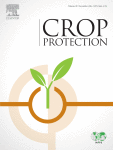Ver ítem
- xmlui.general.dspace_homeCentros Regionales y EEAsCentro Regional Salta - JujuyEEA SaltaArtículos científicosxmlui.ArtifactBrowser.ItemViewer.trail
- Inicio
- Centros Regionales y EEAs
- Centro Regional Salta - Jujuy
- EEA Salta
- Artículos científicos
- Ver ítem
Long-term effect of tillage systems on soil microbiological, chemical and physical parameters and the incidence of charcoal rot by Macrophomina phaseolina (Tassi) Goid in soybean
Resumen
A 20-year field experiment was employed with the aim of evaluating the effect of tillage systems on biological, chemical and physical aspects of the soil, and to establish whether there was a correlation of these parameters with the incidence of charcoal rot (Macrophomina phaseolina) of soybean and crop yield. The tillage systems evaluated were direct seeding (DS), DS + scarifier (DS + S), minimum tillage (MT) and conventional tillage (CT). DS presented
[ver mas...]
A 20-year field experiment was employed with the aim of evaluating the effect of tillage systems on biological, chemical and physical aspects of the soil, and to establish whether there was a correlation of these parameters with the incidence of charcoal rot (Macrophomina phaseolina) of soybean and crop yield. The tillage systems evaluated were direct seeding (DS), DS + scarifier (DS + S), minimum tillage (MT) and conventional tillage (CT). DS presented higher values than CT in culturable total fungi (26.33 × 105 vs. 2.33 × 105 CFU g−1 dry soil), total bacteria (182 × 107 vs. 64 × 107 CFU g−1 dry soil), microbial respiration (0.77 mg CO2 g−1 week−1 vs. 0.45 mg CO2 g−1 week−1) and fluorescein diacetate (FDA) hydrolysis (4.17 ug fluorescein g−1 h−1 vs. 1.70 ug fluorescein g−1 h−1 in CT. Fungal and bacterial community fingerprints, by terminal restriction fragment length polymorphism (T-RFLP) analysis, of Intergenic spacer regions of rRNA and 16S rRNA genes, respectively, were influenced by the tillage system. Also FAME (fatty acid methyl ester) profiles showed that microbial community structure in DS and CT was clearly different. DS samples contained significantly higher total microbial biomass than the other tillage treatments, but there were no significant differences in fungal biomass or any consistent trend with respect to stress index. Our results showed that microbial communities were more abundant and active in DS than in CT in response to high nutrient content in soil. Indeed, DS systems presented higher soil OM, total N, K and Ca than CT. Electrical conductivity and aggregate stability (AS) were also improved by DS. Soybean grown in high-quality soil was not affected by charcoal rot, however, under CT, disease incidence in soybean was 54%. These differences were correlated to the higher microbial abundance and activity under DS, the biological component being a key factor determining soil capacity to suppress the soilborne pathogen.
[Cerrar]

Autor
Perez Brandan, Carolina;
Arzeno, Jose Luis;
Huidobro, Dina Jorgelina;
Grumberg, Betiana Clarisa;
Conforto, Erica Cinthia;
Hilton, Sally;
Bending, Gary D.;
Meriles, Jose Manuel;
Vargas Gil, Silvina;
Fuente
Crop Protection 40 : 73-82 /October 2012)
Fecha
2012-10
Editorial
Elsevier
ISSN
0261-2194
Formato
pdf
Tipo de documento
artículo
Palabras Claves
Derechos de acceso
Restringido
 Excepto donde se diga explicitamente, este item se publica bajo la siguiente descripción: Creative Commons Attribution-NonCommercial-ShareAlike 2.5 Unported (CC BY-NC-SA 2.5)
Excepto donde se diga explicitamente, este item se publica bajo la siguiente descripción: Creative Commons Attribution-NonCommercial-ShareAlike 2.5 Unported (CC BY-NC-SA 2.5)

